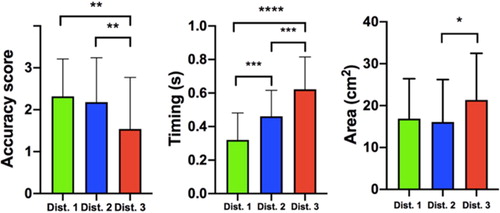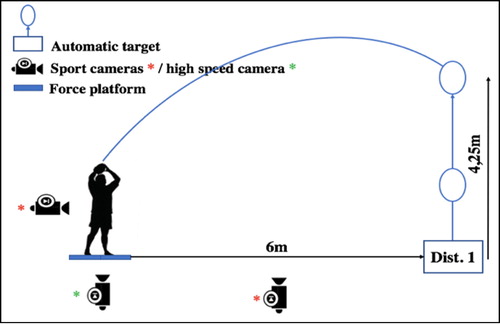1. Introduction
In Rugby Union, the lineout is a play phase whose performance significantly influences the overall team performance during a game. Indeed, winning teams lose fewer balls during their lineout plays compared to losing teams (Ortega et al. Citation2009). The lineout throw requires several skills so that the ball to be projected at appropriate height, velocity and angle to be caught by a jumper at variable distances. Despite the importance of the lineout throwing in rugby, few biomechanical studies are present in the scientific literature. These researches highlighted the importance of kinematic analysis and assessed throw accuracy with various methods: under ecological conditions (Sayers Citation2011) or using fixed target (Trewartha et al. Citation2008). However, accuracy is not the only parameter in achieving a successful throw. Good timing with the jumper ascension is also essential to offer a minimum of time to the opponent to intercept the ball. The aim of this study was to evaluate the biomechanical performance of the lineout throwing by using an innovative device and methods to assess both the accuracy and the timing of the throw. Intra and interpersonal comparisons of kinematic and dynamic parameters were made to characterize throw performance under distance variable conditions.
2. Methods
2.1. Participants
5 professional male subjects evolving at the hooker position within the team of Racing 92 participated in this study (mean ± SD: age = 23 ± 3.8 years, body mass = 106.8 ± 4.2 kg, height = 182 ± 2 cm).
2.2. Procedures
The throws were made towards an automatic robot (Touch’Trainer by SERMAZ), which includes a telescopic mast allowing a target to reach a height of 4.25 m into 0.75 s. The trigger of the device began after a 5 indicator lights countdown, allowing the subject to anticipate the rise of the target. These characteristics, simulating the jumper ascent, put the thrower in specific conditions to work on two performance factors: accuracy and timing. After a specific warm-up and a period of protocol habituation, 30 throws were realized according to 3 distances: 6 m (dist.1), 10 m (dist. 2) and 15 m (dist. 3), in a randomized order. Trials took place indoors, but under usual training conditions: on synthetic grass and in rugby boots ().
2.3. Analyzed parameters
Each throw was filmed by two sport video cameras, one positioned behind the subject (60 fps), and the other in the normal plane to the ball trajectory (24 fps). The performance parameters, composed of the throw accuracy and the throw timing were analyzed using Kinovea software. Throw accuracy was defined on a 4-points scale depending on the ball impact location on the target. Throw timing was defined as the delay between the end of the target ascent and the ball impact on the target. Ball kinematic parameters were evaluated using a high speed camera (FASTCAM; 250 fps), positioned on the throwing hand side of the subject. Ejection velocity, ball spin velocity, ball release angle and ball path length in the thrower hands during the ejection phase were calculated. Twelve reflective body landmarks were also marked to evaluate thrower kinematic. Dynamic parameters were computed using two force plates (AMTI; 250 Hz). The peak ground reaction force during the ejection phase and the 95% confidence ellipse area of the center of pressure displacements were assessed using Matlab routines. For each parameter, differences between throw distances were identified by analysis of variance (ANOVA) followed by Tukey’s multiple comparison test. To characterize thrower specificities, interpersonal comparisons were also realized, regardless of the distance.
3. Results and discussion
The throw performance parameters were significantly different depending on the throw distance, but not depending on the thrower. Indeed, accuracy scores were significantly lower in dist. 3 than in dist. 2 and in dist. 1 (p < 0.05) ().
Figure 2. Accuracy score (A); Throw timing (B) and CoP ellipse area (Zemková). *p < 0.05; **p < 0.01; ***p < 0.001; ****p < 0.0001.

Timing values exhibited gradual increases as distance increased (p < 0.0001) (). These results highlight an overall decrease in throw performance when the distance increases. This degradation, notably illustrated by the increasing timing values, could be explained by the anticipation demands which become more challenging at the longest distances. Perceptual training to improve trajectories anticipation seems to be an interesting strategy to optimize this parameter (Faubert and Sidebottom Citation2012). Interpersonal differences seem to appear, but without reaching the significant threshold, which could indicate a similar level of performance.
Several biomechanical parameters were impacted by the throw distance. Indeed, there was an increase in ball ejection velocity, ball release angle, vertical (Y) ball path length in the thrower hands and peak ground reaction force (p < 0.0001) with the distance. The center of pressure (CoP) ellipse area also increased but only in dist. 3 (p < 0.05) (). Moreover, we noticed significant differences between throwers concerning ball spin velocity, CoP ellipse area and shoulder and elbow joint range of motion during the ejection phase (p < 0.0001).
The increase in the biomechanical parameters reflects the principles of the dynamic which are essential to throw under variable distance conditions (Trewartha et al. Citation2008). Interestingly, the increase in the CoP ellipse area, that indicates a deterioration of postural stability (Zemková Citation2014), was observed at the distance where the throws were the least performant. Indeed, this degradation, particularly observed in 3 of 5 throwers, seems to be associated with the decrease of their accuracy score in dist. 3. The link between accuracy and dynamic postural stability has already been established in various specific sport skills such as the free throw in basketball (Zemková Citation2014), but not in rugby.
Finally, the interpersonal differences that have been noted, reflect the presence of specific propulsive methods characterized by a predominant use of shoulder adduction or elbow extension during the ejection phase. It reinforces observations of previous researches concerning the presence of individual motor signature (Sayers Citation2011).
4. Conclusions
The innovative device and methods proposed in this study highlighted a throw performance deterioration in the longest distance. The biomechanical analysis brought new elements for the design of a performance model and offer to sport staff important information to design individual training programs. Several perspectives are considered such as a more detailed thrower kinematic evaluation or the implementation of a perceptual-cognitive training strategy to optimize the lineout throwing performance.
Disclosure statement
No potential conflict of interest was reported by the author(s).
Funding
The authors would like to acknowledge Racing 92 for the funding and the high involvement of its sport staff and the French Rugby Federation (FFR) for the loan of the Touch’Trainer.
References
- Faubert J, Sidebottom L. 2012. Perceptual-cognitive training of athletes. J Clin Sport Psychol. 6(1):85–102.
- Ortega E, Villarejo D, Palao JM. 2009. Differences in game statistics between winning and losing rugby teams in the six nations tournament. J Sports Sci Med. 8(4):523–527.
- Sayers MGL. 2011. Kinematic analysis of line-out throwing in elite international rugby union. J Sports Sci Med. 10(3):553–558.
- Trewartha G, Casanova R, Wilson C. 2008. A kinematic analysis of rugby lineout throwing. J Sports Sci. 26(8):845–854.
- Zemková E. 2014. Sport-specific balance. Sports Med. 44(5):579–590.

